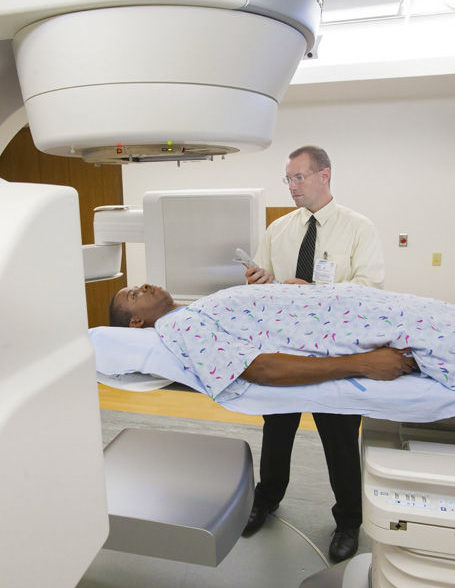
While the expansion of the Indian River Medical Center’s Scully-Welsh Cancer Center continues on the outside, on the inside physicist James Atherton, Ph.D. and Dustin Boring, manager of radiation therapy, have been going through some really heavy remodeling of their existing work space: 50 tons worth of remodeling, to be precise.
That’s because IRMC has now become only the fourth hospital in the state of Florida to install the newest TrueBeam STx™ stereotactic radiosurgery system. According to the Norton Cancer Institute, this particular system is “the latest and most advanced technology in the world for treating cancer.” And those 50 tons worth of remodeling? That was the 100,000 pounds of additional lead installed into the walls for radiation safety purposes.
Just what is stereotactic radiosurgery and what makes the TrueBeam STx™ such a cutting edge tool?
The American Cancer Society defines radiosurgery as “therapy that uses high-energy particles or waves, such as x-rays, gamma rays, electron beams, or protons, to destroy or damage cancer cells.” The word “stereotactic” denotes the use of 3-D imaging in the process but despite its name, stereotactic radiosurgey is actually a non-surgical procedure. There are no scalpels, no clamps and no sutures. Instead, the TrueBeam STx™ system delivers its radiation beams through the air and directly into the patient’s tumor(s) with near pinpoint accuracy, precision, ease and speed compared to the previous generations of radiotherapy systems. In fact, according to Boring, this new TrueBeam STx™ system can deliver a prescribed dose of radiation treatment so much faster than older versions did that many patient sessions now last less than 15 minutes.
“This is a game-changer that will enable us to treat even the most challenging cancer cases with unprecedented speed and precision,” said Lori McCormick, administrative director at the cancer center. “Almost everyone is touched by cancer at some point whether personally or through a loved one and we are glad to provide this type of cancer technology so close to home.”
Dr. Stuart Byer, a radiation oncologist at IRMC, says the new device opens the door to exciting possibilities for treating challenging cancers in the lung, breast, abdomen, head and neck and other cancers, too. “We have significantly increased our treatment capabilities, that allows us to tailor treatments for a patient’s specific circumstance,” he said. “The TrueBeam machine is fully operational and so far the results have been everything we’d hoped for, treating and caring for the whole patient.”
Looking like a monumentally outsized white enamel kitchen faucet with wings, the TrueBeam device can rotate all around a patient to deliver the prescribed radiation dose from nearly any angle, making hard to reach tumors not so hard to reach anymore. Perhaps more importantly, the new system boasts an accuracy level as tight as 1.5 millimeters. That’s approximately 1/16 of an inch or the thickness of a penny, which help keep radiation from hitting and unnecessarily damaging nearby healthy cells while the targeted tumor gets more radiation than earlier versions were able to accurately deliver.
At the same time, built-in, real time 3-D imaging tools allow doctors and clinicians to actually see the tumor they are targeting while the system also simultaneously monitors and compensates for any movements the patient might make, including movements as subtle as simply breathing in and out. The system also provides for the use of more than one high-energy beam at a time and clinicians can vary the radiation dosages being delivered to multiple treatment areas.
Atherton, meanwhile, has been busy doing more than just overseeing installation of 50 tons of lead. Certified by the American Board of Radiology in both therapeutic and diagnostic radiological physics, he also took on the long and arduous task of “commissioning” the new True Beam system. That’s a nice way of saying he ran thousands of calculations, entered a massive amount of data and monitored scores of tests to get the system up and running.
The TrueBeam STx™ system is not something anyone can just pull out of a (very big) box, plug into a wall socket and start treating patients. It took Dr. Atherton approximately a month to get it up and running for its first radiotherapy treatment, which took place on Nov. 5.
So, while the brick and mortar expansion of IRMC’s Cancer Center continues to proceed on schedule on the outside, on the inside that expansion is going even faster now that the TrueBeam STx™ system is fully operational.



